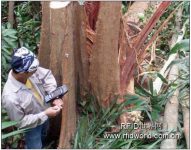
The Ministry of Forestry of Malaysia uses RFID to track timber and manage forests
[ad_1]
The Forestry Department of Peninsular Malaysia (FDPM) recently completed a pilot project-the use of RFID to track timber and manage forests. Malaysia is one of the world’s largest exporters of forest resources. In 2008, the export value of timber and timber products reached 6.3 billion U.S. dollars.
Malaysia and the EU are currently negotiating a voluntary cooperation agreement based on EU roundwood and wood product regulations. The EU requires wood product exporting countries to abide by a set of rules to ensure that the legal logging of product logs conforms to the laws of environmental sustainability. The EU also requires transparency in the control and monitoring process. Once these controls and procedures are in place, the Malaysian government can authorize the issuance of export certificates that comply with EU standards, while also combating illegal logging. Among them, one of the requirements of the agreement is to adopt a national timber tracking system to improve the transparency and traceability of the timber supply chain.
Currently, in Peninsular Malaysia, trees are manually counted by reading the identification codes on the tree signs with the naked eye. However, manual systems are difficult to trace every piece of processed wood, especially unable to maintain complete written records throughout the supply chain to ensure the delivery of all taxes and the legal logging of logs. An automatic system can solve these problems. To this end, FDPM invited some technology suppliers to test forest management systems based on RFID and barcode technology. Tracking software provider Helveta became the only partner company in the initial phase of the project. The company was appointed to cooperate with the Terengganu Department of Forestry (TSFD) on a 129,143 hectares of forest land.

A forestry worker uses a handheld to read tree tags
The purpose of the pilot project is to demonstrate whether the RFID system is sufficient to meet the legal needs of wild forest land, said Nigel Dore, Helveta’s chief technology officer. “This system supports tree pre-cutting inventory and collecting cutting information; when trees are cut into round logs at the storage yard, and when the round logs are transported out of the forest, the information is obtained when they pass the TSFD checkpoint outside the forest,” he explained.
All trees tracked in the chain of custody are affixed with passive UHF tags that comply with EPC Gen 2 and ISO 18000-6C standards. The project team adopted two types of tags based on supply capacity and appearance. One type of tag runs at 860-960 MHz, and the other at 865-869 MHz.
RFID tags are fixed with U-shaped nails or hammered into trees or logs. Although the label lacks a special bead protection shell, neither method will damage the label. The project uses four RFID Teklogix Workabout handhelds running Helveta’s mobile data acquisition software to read the unique ID code of each tag. Starting from the woodland, RFID Workabout equipment is used to confirm the tag ID code at various checkpoints in the supply chain.
A total of 242 trees were counted, 62 of which were felled during the testing period, so 188 were labeled and 81 passed through various checkpoints in the chain of custody. During the project, the staff set up checkpoints at various locations where the supervisory authority changed, including the locations where the original trees were counted, felled and processed into round logs, and the time for the timber to arrive and leave the yard and pass through a roadside state forest station .
Helveta’s CI World platform is used as a central database to manage data and generate online reports based on the collected data, thereby providing visibility into the circulation of wood and wood products in the supply chain. The data stored in the Psion Teklogix device is uploaded to an online notebook in the main office via a USB connection. Information can also be transmitted via a wireless Wi-Fi interface or a mobile network connected by GPRS.
Project reports include official forms such as pre-harvesting inventories and company documents. CI World checks, analyzes and merges all the acquired data; when the data is inconsistent, the system will also generate an alert.
According to Dore, RFID systems have many advantages compared to barcodes. These advantages include RFID reading and writing capabilities, tags can be written into the history of the pasted products; high-speed identification of logs; automatic production of RFID reports, such as inventory, yard reports, etc., these include RFID ID codes for confirmation and repeated inspections.
According to Dore, this system can support forest inventory and management activities, such as planting plans; it can also manage forest-related documents, tree processing, transportation, and export information; support an alarm system; automatically calculate and collect taxes to improve the account Transparency, identification of illegal activities.
The design of this system took 5 weeks, the tree inventory took two days, and the chain of custody field test lasted 10-12 days. Terengganu Province is expected to fully implement the forest tracking project next year. It has not yet been determined whether to use only RFID, or barcodes, or a combination of applications.
[ad_2]




